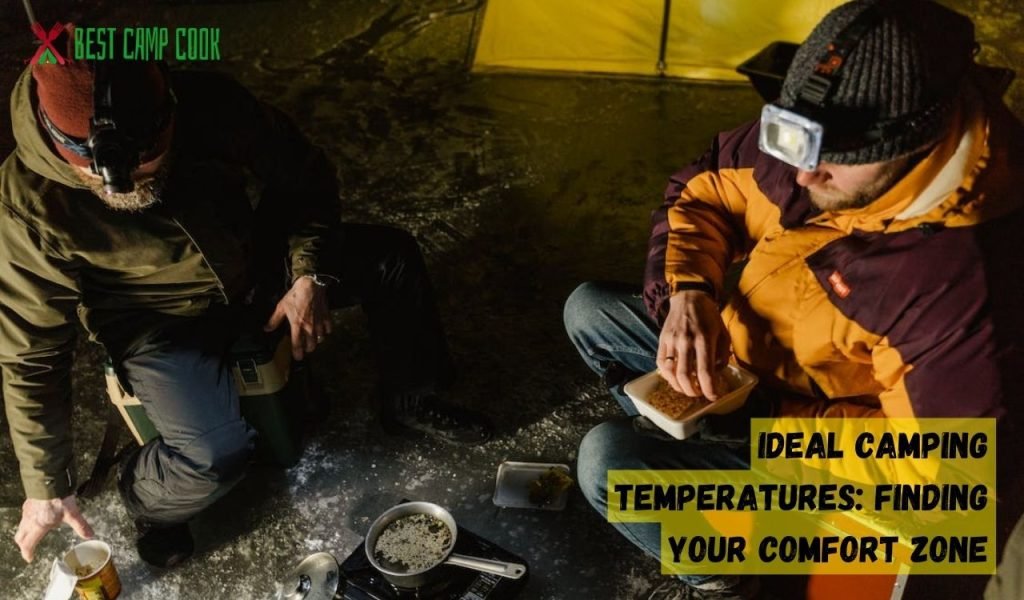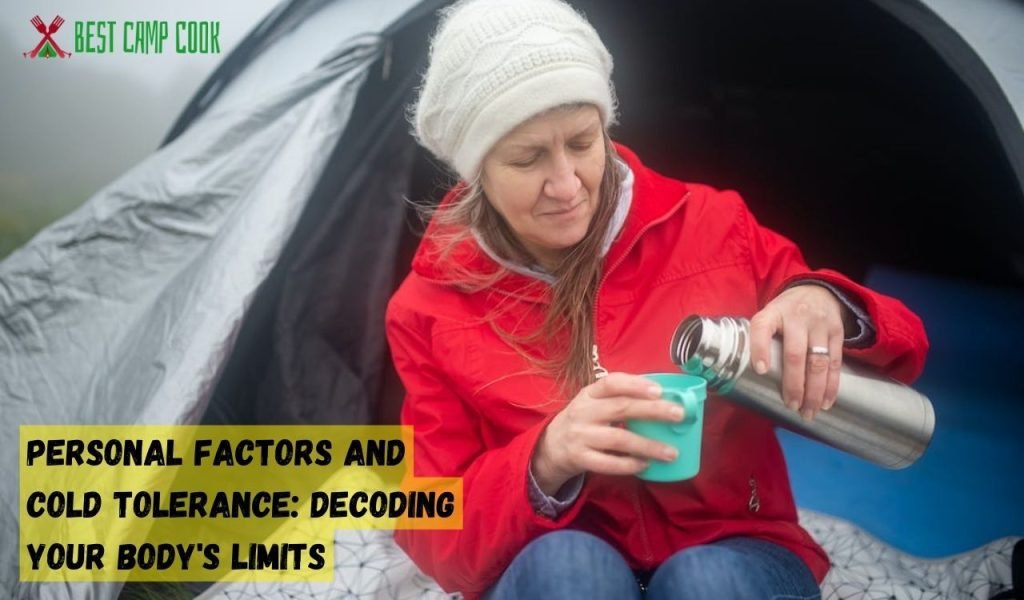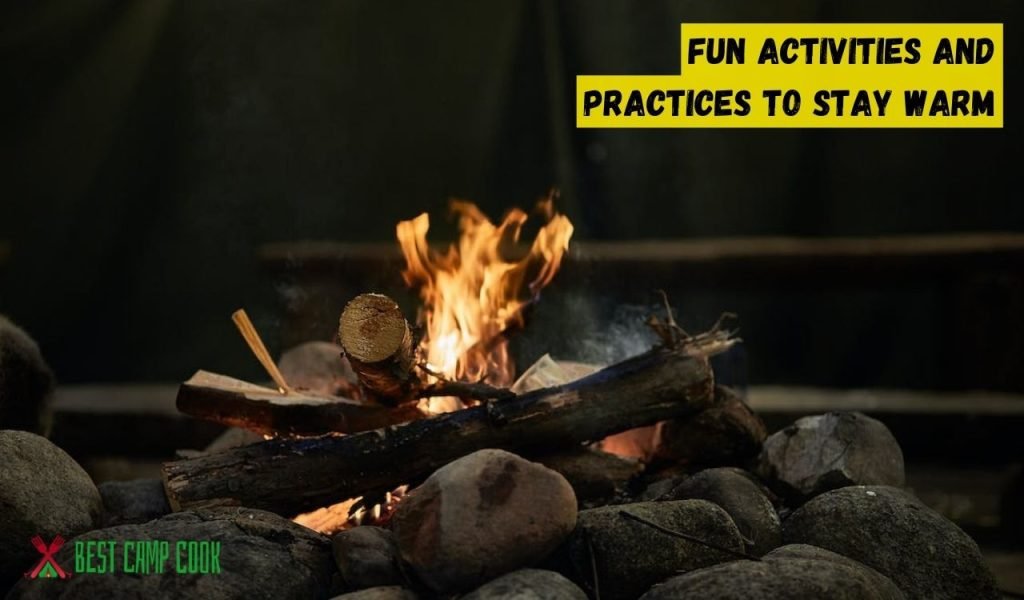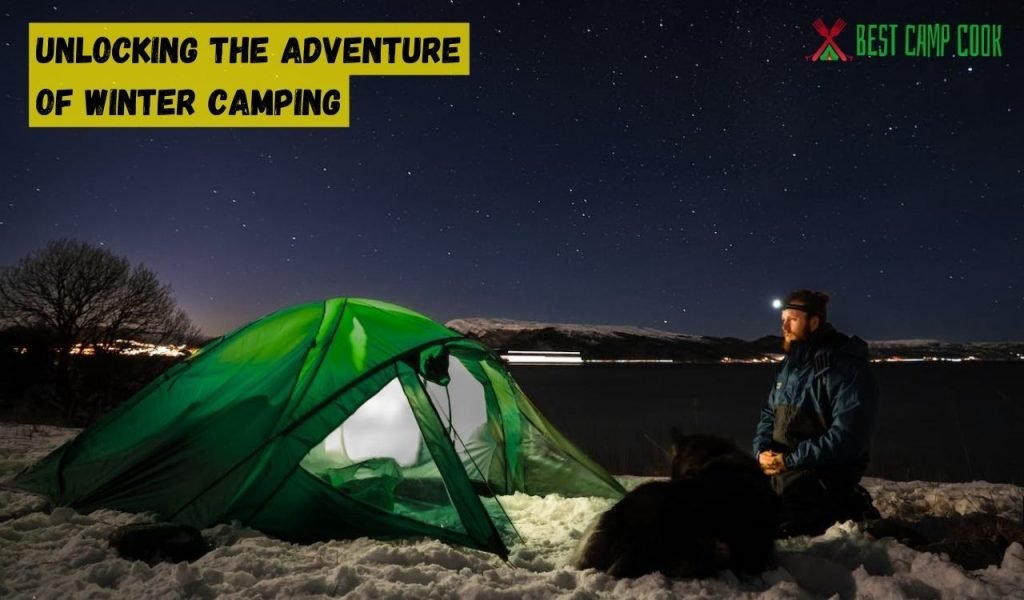Physical Address
304 North Cardinal St.
Dorchester Center, MA 02124
Physical Address
304 North Cardinal St.
Dorchester Center, MA 02124

How cold is too cold to camp? Wondering if you should pack up your gear and head indoors when the temperatures drop? We’ve got you covered! In this guide, we’ll unravel the mystery of determining the perfect camping temperature and provide you with valuable insights on storing camping gear in cold conditions.
From frosty adventures to cozy escapes, we’ll explore the limits of chilly camping and help you find your comfort zone. Whether you’re a seasoned outdoors enthusiast or a novice camper, understanding the threshold of coldness can make all the difference in your camping experience.
So, grab a warm beverage, bundle up, and join us as we delve into the intriguing world of camping in cold conditions. Let’s find out how to stay snug, enjoy the great outdoors, and ensure the safety of your camping gear, no matter how low the mercury dips!
Main Summary: How Cold is Too Cold to Camp?
The ideal camping temperature varies based on location, activities, and personal preferences. Understanding cold tolerance is vital. Usually, anything below 20°F(-6° C) is considered too cold for camping. Camping below 20°F can be dangerous without proper gear, shelter, and experience.
Camping is an exhilarating outdoor activity that allows us to connect with nature and create lasting memories. However, when the temperatures drop, it’s essential to consider how cold is too cold to camp. In this article, we will explore the ideal camping temperatures and help you find your comfort zone amidst chilly conditions. Let’s dive in!

Choosing the right camping temperature range is crucial for a pleasant and enjoyable outdoor experience. The ideal camping temperature can vary depending on personal preferences, location, and the activities you plan to engage in during your camping trip. Finding your comfort zone amidst fluctuating temperatures requires careful consideration. Let’s explore the factors that contribute to identifying the ideal camping temperatures and how you can find your sweet spot.
The first step in determining ideal camping temperatures is to understand the climate and weather conditions of your camping destination. Different regions have varying temperature ranges throughout the year. Research the average temperatures during the season you plan to camp in and take note of any extreme weather patterns. This information will give you a general idea of what to expect and help you prepare accordingly.
The activities you engage in during your camping trip play a significant role in determining the ideal temperature range. For instance, if you plan to embark on strenuous hiking or physical activities, you may prefer cooler temperatures to avoid excessive sweating and discomfort. On the other hand, if your camping experience revolves around relaxation and leisurely pursuits, you might lean towards warmer temperatures for a more comfortable and cozy atmosphere.
Understanding your personal comfort preferences is essential in defining the ideal camping temperature for you. Some individuals prefer cooler temperatures and enjoy the crispness of the air, while others gravitate towards warmer climates for a more soothing experience. Consider your own temperature sensitivities and what makes you feel most comfortable in outdoor settings. Experimentation and past camping experiences can guide you in determining the temperature range that aligns with your preferences.
The time of year and seasonal variations greatly influence the ideal camping temperature range. Spring and fall often offer milder temperatures, making them popular seasons for camping.
Summer can bring warmer temperatures, particularly in certain regions, which may require additional measures to stay cool and comfortable. Winter camping enthusiasts embrace colder temperatures but must be well-prepared with appropriate gear and clothing. Consider the season and its associated temperature range to narrow down your ideal camping temperatures.
Flexibility and adaptability are essential when it comes to camping temperatures. Mother Nature can be unpredictable, and temperature fluctuations are common, even within a single day.
Being open to adjusting your comfort expectations and having the ability to adapt to changing conditions will enhance your camping experience. Layering clothing, having versatile gear, and being prepared for unexpected temperature shifts will allow you to adapt to varying conditions and find comfort within a wider temperature range.

Understanding your body’s response to cold temperatures is vital in identifying your camping comfort zone. Factors such as age, health, and overall fitness can significantly impact your tolerance to cold weather.
Some individuals naturally withstand lower temperatures, while others may feel discomfort even in milder conditions. Analyzing your personal cold tolerance will help you gauge the lower temperature limits for your camping trip. Let’s delve into the key factors that influence cold tolerance and how to decode your body’s limits.
Age plays a significant role in how our bodies handle cold temperatures. Infants and young children, as well as older adults, tend to have less efficient thermoregulatory systems, making them more vulnerable to extreme cold.
They may lose body heat more rapidly and struggle to maintain a comfortable internal temperature. If you fall into these age brackets, it’s important to take extra precautions and be mindful of lower temperature thresholds when planning your camping trips.
Individuals with pre-existing health conditions may have reduced cold tolerance. Certain medical conditions, such as circulatory problems or thyroid disorders, can affect blood circulation and hinder the body’s ability to retain heat.
Additionally, poor physical fitness and low body fat percentage can make it more challenging to stay warm in colder temperatures. Engaging in regular exercise and maintaining a healthy lifestyle can improve your body’s ability to handle the cold.
Regular exposure to cold temperatures can enhance your body’s ability to adapt and tolerate lower temperatures over time. People who live in colder climates or frequently engage in outdoor activities during the colder months often develop better cold tolerance compared to those who are not regularly exposed to cold environments.
If you’re new to camping or planning a trip in colder weather, gradually exposing yourself to lower temperatures before the camping adventure can help your body adjust and increase your cold tolerance.
Body composition, particularly the distribution of body fat and muscle mass, can influence your ability to stay warm in cold conditions. Fat acts as insulation, providing a layer of warmth and helping to retain body heat.
Those with a higher percentage of body fat may have a greater advantage in cold weather compared to individuals with lower body fat percentages. However, it’s important to note that overall fitness and health are more critical factors in cold tolerance than just body composition alone.
It’s crucial to recognize that individual variations in cold tolerance exist. Each person’s perception of cold can differ, and what feels comfortable for one individual may be too cold for another. Factors such as genetics, metabolism, and even psychological factors can contribute to these variations.
Understanding your own body’s response to cold weather through personal experience and experimentation is key to determining your comfort zone when camping in colder temperatures.

Once you’ve assessed your cold tolerance, it’s time to prepare for camping in colder weather. Here are some tips to navigate cold weather camping with confidence:
Dressing appropriately is key to staying warm during chilly camping adventures. Layering your clothing allows for better temperature regulation as you can add or remove layers as needed. Start with a moisture-wicking base layer, followed by insulating layers such as fleece or wool, and finish with a waterproof and wind-resistant outer shell. Don’t forget to protect your extremities with warm hats, gloves, and thick socks.
Investing in high-quality sleeping gear designed for cold weather is essential. Opt for a sleeping bag with an appropriate temperature rating for the coldest conditions you expect to encounter. Additionally, insulate your sleeping pad to prevent heat loss from the ground.
Choosing the right shelter is crucial when camping in colder temperatures. A four-season tent with proper insulation and wind resistance will provide better protection from the elements. Consider camping in areas with natural windbreaks or choose campsites that are sheltered from strong winds. Setting up camp in areas that receive sunlight during the day can also help in warming up the surroundings.
A well-maintained campfire can be a valuable source of warmth during cold camping trips. Learn proper fire-building techniques and ensure you have enough firewood. Additionally, portable heat sources like camping stoves or heaters can provide extra warmth, but exercise caution and follow safety guidelines when using them.

Before embarking on a cold weather camping trip, it’s essential to plan and prepare in advance. Research the camping area, including weather patterns, terrain, and available amenities. Create a checklist of necessary gear, clothing, and food supplies. Inform someone of your camping plans and expected return date for safety purposes.
Ensure that all your camping gear is in good condition and suitable for cold weather conditions. Inspect your tent for any leaks or damage and consider using a four-season tent designed for winter camping. Test your stove, fuel, and cooking equipment to ensure they function properly in colder temperatures. Check that your sleeping bag and sleeping pad provide adequate insulation for cold nights.
Layering is key to staying warm during cold weather camping. Wear moisture-wicking base layers to keep your body dry and prevent moisture from cooling your skin. Add insulating mid-layers such as fleece or down jackets to provide warmth. Finally, top it off with a waterproof and windproof outer shell to protect against the elements. Don’t forget to wear warm socks, gloves, a hat, and a scarf to protect your extremities.
Cold weather camping requires additional energy to keep your body warm. Pack high-calorie, nutrient-dense food that is easy to prepare and consume in cold conditions. Choose foods that provide a good balance of carbohydrates, fats, and proteins. Stay hydrated by drinking plenty of fluids, even if you don’t feel thirsty, as cold weather can lead to increased fluid loss through respiration.
Building a fire can provide warmth and comfort during cold weather camping, but it’s crucial to practice fire safety. Choose designated fire pits or fire rings, and avoid building fires near flammable materials or vegetation. Keep a sufficient supply of firewood and fire starters. Always fully extinguish the fire before leaving the campsite or going to sleep.
Physical activity generates heat and helps you stay warm in cold weather. Engage in light exercises or activities that keep your blood flowing and body warm. Take short walks or hikes, do some stretching exercises, or engage in campsite chores. Avoid prolonged periods of inactivity, as it can lead to feeling colder.
Ensure a comfortable and warm night’s sleep by following a few tips. Use a high-quality cold-weather sleeping bag with the appropriate temperature rating. Place an insulating sleeping pad beneath your sleeping bag to provide an additional barrier from the cold ground. Wear a hat and keep your extremities warm by using warm socks and gloves. Consider using a hot water bottle inside your sleeping bag for added warmth.

Invest in a high-quality insulated sleeping bag designed for cold weather camping. Look for a bag that is rated for temperatures lower than what you expect to encounter during your camping trip. Consider the insulation type, such as down or synthetic, and choose according to your personal preferences and budget.
A good sleeping pad is essential to provide insulation and cushioning between you and the cold ground. Opt for a pad with a high R-value, which indicates its thermal resistance. The higher the R-value, the better it will insulate you from the cold ground.
Dressing in layers is crucial for cold weather camping. Start with a moisture-wicking base layer to keep your body dry. Add insulating mid-layers such as fleece or down jackets for warmth. Top it off with a waterproof and windproof outer shell to protect against the elements. Don’t forget to wear appropriate accessories like warm socks, gloves, hats, and scarves.
A four-season tent is specifically designed to withstand the challenges of winter camping. These tents offer sturdier construction, additional support for snow loads, and better insulation. Look for a tent with a full-coverage rainfly and strong poles to handle harsh weather conditions.
Choose a reliable and efficient portable stove that can handle cold temperatures. Opt for a stove that uses fuel types suitable for cold weather, such as white gas or canister fuel designed for winter use. Carry enough fuel for your entire trip, considering the increased consumption in colder conditions.
Invest in insulated and waterproof footwear to keep your feet warm and dry during cold weather camping. Look for boots with good insulation, a waterproof membrane, and sturdy soles for traction on icy or snowy terrain. Make sure the boots provide enough room for thicker socks without being too tight.
Additional gear for cold weather camping includes a headlamp or flashlight, extra batteries, a repair kit for your gear, a multi-tool, a first aid kit, and a navigation device. These items ensure your safety and provide convenience during your camping adventure.

When setting up your campsite in cold weather, choose a location that provides natural windbreaks or use man-made windbreaks like snow walls or tarps. Look for areas with trees or natural formations that can offer protection from the wind. A sheltered campsite helps retain heat and makes camping more comfortable.
Clear the snow or debris from the ground where you plan to set up your tent. This helps create a flat and stable surface. If the ground is frozen, you can use a snow shovel or other tools to remove the top layer. Level the area and create a platform by compacting the snow or using a tarp as a base.
To maximize insulation, place an insulating layer beneath your tent. This can be a foam pad or a specially designed tent footprint. It helps prevent heat loss through conduction. Additionally, consider using a tent with a full-coverage rainfly to create an extra barrier against wind and cold.
If your campsite doesn’t offer natural windbreaks, you can create your own using snow walls or tarps. Build walls made of compacted snow around the perimeter of your campsite to block the wind. Ensure the walls are sturdy and tall enough to provide effective protection. Alternatively, set up tarps strategically to create a windbreak.
Setting up a heat source inside your tent can significantly increase comfort during cold weather camping. Use a camping heater specifically designed for indoor use, ensuring it is safe and vented properly. Alternatively, you can use a hot water bottle or heat packs to warm up your sleeping bag before bedtime.
Keep your campsite organized to optimize comfort and efficiency. Assign specific areas for cooking, sleeping, and storing gear. To enhance your camping experience, it’s important to set up a good camping kitchen as well. This involves creating a designated space for cooking and preparing meals. You can utilize a camping table or a flat surface to act as your kitchen counter.
To minimize exposure to the cold weather, consider setting up a vestibule or using a tarp to create a sheltered area specifically for cooking or relaxing. This will provide protection from wind and precipitation while allowing you to enjoy your meals comfortably. Additionally, it’s essential to store your food properly to prevent it from freezing. Make sure to pack insulated coolers or use ice packs to maintain the appropriate temperature for perishable items.
By implementing these tips, you’ll be able to maintain an organized campsite and enjoy a well-equipped camping kitchen, ensuring a comfortable and efficient outdoor experience
Moisture is your enemy in cold weather camping. Keep your gear and clothing dry to maintain warmth. Use a vestibule or designated area to remove wet or snowy gear before entering your tent. Stay hydrated by drinking plenty of fluids, even if you don’t feel thirsty, as dehydration can increase the risk of hypothermia.

Engaging in physical activities generates body heat, helping you stay warm. Plan activities like hiking, snowshoeing, or skiing to keep your body moving and maintain a comfortable temperature. Remember to dress appropriately for the activity and layer your clothing to regulate your body heat effectively.
Gathering around a crackling campfire not only provides warmth but also creates a cozy ambiance. Enjoy classic campfire treats like roasted marshmallows, s’mores, or warm beverages. Bring along a camping stove or a portable grill to cook hearty meals that warm you from the inside out.
Sipping on warm beverages is a comforting way to stay cozy in cold weather. Pack a thermos with hot chocolate, tea, coffee, or soup. These beverages not only help warm you up but also provide nourishment and hydration during your camping trip.
Engage in group activities and games to generate body heat and have fun with your camping companions. Play active games like snowball fights, winter sports, or team-building activities. Keeping your body active and engaged helps maintain your body temperature and adds excitement to your camping experience.
Heat packs and hand warmers are practical and portable solutions for staying warm during cold weather camping. These small packets generate heat when activated and can be placed in pockets, gloves, or sleeping bags. They provide localized warmth and are especially useful during colder nights.

Hypothermia is a serious condition that occurs when the body loses heat faster than it can produce, resulting in a dangerously low body temperature. Look out for the following signs:
If you or someone in your camping group exhibits these symptoms, take immediate action. Move to a warm and sheltered area, remove wet clothing, and wrap the person in warm blankets or sleeping bags. Provide warm liquids if conscious and seek medical help as soon as possible.
Frostbite is a freezing of the skin and underlying tissues caused by exposure to extreme cold. It typically affects the extremities such as fingers, toes, ears, and nose. Be aware of the following signs:
If frostbite is suspected, it’s crucial to act promptly. Move to a warm place, remove wet clothing, and gradually warm the affected area using body heat or warm (not hot) water. Avoid rubbing or massaging the frostbitten area. Seek medical assistance for proper evaluation and treatment.

Winter camping offers a unique opportunity to experience the tranquility and beauty of nature in its frozen state. Embrace the peacefulness, the crisp air, and the stunning landscapes blanketed in snow. Take the time to appreciate the solitude and the extraordinary sights that winter camping has to offer.
Winter landscapes provide breathtaking scenes that are perfect for photography. Capture the glistening snow, ice formations, and the golden hues of sunrise or sunset. Experiment with long exposures to capture the beauty of falling snowflakes or the clarity of starry nights. Let the winter wonderland become your photography playground.
Winter camping presents an opportunity to learn valuable survival skills. Take the time to educate yourself on topics such as building snow shelters, navigation techniques in snowy conditions, and winter first aid. Acquiring these skills not only enhances your safety but also empowers you to explore and enjoy winter camping with confidence.
If you’re new to winter camping or want to enhance your skills, consider seeking guidance from experienced outdoor enthusiasts or professional guides. They can provide valuable insights, teach you essential techniques, and ensure you have a safe and enjoyable winter camping experience.
Join local outdoor clubs or online communities dedicated to winter camping. Engage with fellow outdoor enthusiasts to share experiences, learn from their insights, and discover new camping destinations.
Building connections with like-minded individuals adds a social aspect to your winter camping adventures and opens doors to new friendships and shared experiences. Remember, winter camping requires careful planning, preparation, and awareness of potential risks. By incorporating these tips and practices, you can unlock the adventure of winter camping while staying safe, warm, and connected with nature.
A too cold temperature for camping can vary depending on individual tolerance and preparedness. However, generally, temperatures below freezing (0 degrees Celsius or 32 degrees Fahrenheit) without appropriate gear and shelter can be uncomfortably cold and risky.
Extreme cold is typically considered to be when temperatures fall below -20 degrees Celsius (-4 degrees Fahrenheit). Such temperatures pose significant risks of frostbite, hypothermia, and other cold-related health issues without proper protection.
Camping at 5 degrees Celsius (41 degrees Fahrenheit) can be manageable with adequate cold-weather gear and clothing. However, it’s essential to stay well-insulated and protect against wind chill to ensure a safe and enjoyable experience.
For baby camping, it’s crucial to prioritize safety and comfort. Generally, temperatures below 10 degrees Celsius (50 degrees Fahrenheit) can be unsafe for infants. It’s best to consult a pediatrician and use appropriate gear to ensure the baby stays warm.
Temperatures that dip below freezing, especially in remote areas without access to shelter and warmth, can be dangerous for camping. Extremely low temperatures, below -10 degrees Celsius (14 degrees Fahrenheit), can lead to life-threatening situations if not adequately prepared.
The human body can tolerate a certain level of cold in a camp setting, provided proper precautions are taken. However, prolonged exposure to temperatures below freezing can lead to hypothermia, risking health and safety. It’s essential to dress in layers and seek shelter if conditions worsen.